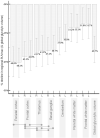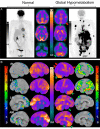Regional changes with global brain hypometabolism indicates a physiological triage phenomenon and can explain shared pathophysiological events in Alzheimer's & small vessel diseases and delirium
- PMID: 35003887
- PMCID: PMC8727878
Regional changes with global brain hypometabolism indicates a physiological triage phenomenon and can explain shared pathophysiological events in Alzheimer's & small vessel diseases and delirium
Abstract
While reduced global brain metabolism is known in aging, Alzheimer's disease (AD), small vessel disease (SVD) and delirium, explanation of regional brain metabolic (rBM) changes is a challenge. We hypothesized that this may be explained by "triage phenomenon", to preserve metabolic supply to vital brain areas. We studied changes in rBM in 69 patients with at least 5% decline in global brain metabolism during active lymphoma. There was significant decline in the rBM of the inferior parietal, precuneus, superior parietal, lateral occipital, primary visual cortices (P<0.001) and in the right lateral prefrontal cortex (P=0.01). Some areas showed no change; multiple areas had significantly increased rBM (e.g. medial prefrontal, anterior cingulate, pons, cerebellum and mesial temporal cortices; P<0.001). We conclude the existence of a physiological triage phenomenon and argue a new hypothetical model to explain the shared events in the pathophysiology of aging, AD, SVD and delirium.
Keywords: Alzheimer’s disease; aging; cerebral metabolism; cerebral perfusion; delirium; dementia; small vessel disease.
AJNMMI Copyright © 2021.
Conflict of interest statement
None.
Figures






Similar articles
-
Longitudinal PET Evaluation of Cerebral Metabolic Decline in Dementia: A Potential Outcome Measure in Alzheimer's Disease Treatment Studies.Am J Psychiatry. 2002 May;159(5):738-45. doi: 10.1176/appi.ajp.159.5.738. Am J Psychiatry. 2002. PMID: 11986126
-
Regional brain hypometabolism is unrelated to regional amyloid plaque burden.Brain. 2015 Dec;138(Pt 12):3734-46. doi: 10.1093/brain/awv278. Epub 2015 Sep 29. Brain. 2015. PMID: 26419799 Free PMC article.
-
FDG PET and MRI in logopenic primary progressive aphasia versus dementia of the Alzheimer's type.PLoS One. 2013 Apr 23;8(4):e62471. doi: 10.1371/journal.pone.0062471. Print 2013. PLoS One. 2013. PMID: 23626825 Free PMC article.
-
Cerebral hypoperfusion and glucose hypometabolism: Key pathophysiological modulators promote neurodegeneration, cognitive impairment, and Alzheimer's disease.J Neurosci Res. 2017 Apr;95(4):943-972. doi: 10.1002/jnr.23777. Epub 2016 Jun 27. J Neurosci Res. 2017. PMID: 27350397 Review.
-
Positron emission tomography in Alzheimer's disease in relation to disease pathogenesis: a critical review.Cerebrovasc Brain Metab Rev. 1991 Winter;3(4):297-335. Cerebrovasc Brain Metab Rev. 1991. PMID: 1772739 Review.
References
-
- Kato T, Inui Y, Nakamura A, Ito K. Brain fluorodeoxyglucose (FDG) PET in dementia. Ageing Res Rev. 2016;30:73–84. - PubMed
-
- Kawasaki K, Ishii K, Saito Y, Oda K, Kimura Y, Ishiwata K. Influence of mild hyperglycemia on cerebral FDG distribution patterns calculated by statistical parametric mapping. Ann Nucl Med. 2008;22:191–200. - PubMed
LinkOut - more resources
Full Text Sources
